This afternoon I emailed the second of a great many sections of A Period Finisher’s Manual to my initial reviewers. I am trying to send them texts in their proper sequence even though that is not how I write them. This one was the introductory soliloquy on Surface Preparation (of wood). The surface preparation during the application of the finish will come much later.
My plan is to send another section every week or ten days, probably longer than today’s 1300 words. I know that the next one, the conclusion to Surface Preparation, is several times longer.
Many tens of thousands of words to get into the hands of the readers. I got my Eames Chair knockoff repaired so I’m good to go in massaging all these parts together.
A couple weeks ago I blogged over at Lost Art Press about the initial distribution of manuscript pieces for A Period Finisher’s Manual to my first-tier reviewers, four hearty volunteers who have pledged to stay with me to the bitter end. I assure you they will be just as tired of the project as I will be by the time it makes it into print. Thanks again Bill, Bob, Gina, and Josh for your yeoman’s work to make this esoteric topic into an engaging and informative volume.
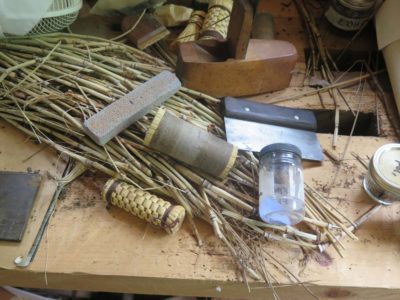
The first broadside was the “Introduction,” a non-technical roadmap for the project. Later this week I will be sending them at least part of (maybe the whole of) the first section, “Preparing the Surface.” There is nary a drum sander or jitterbug to be found.
I look forward to their feedback. Once it gets integrated into the manuscript text, that “final” version will be winging electronically to my second tier reviewers Bill, John, Len, and Mike for any final thoughts before the whole pile lands on The Schwarz’ desk. I have only so many words in me, so periodically I fall silent here as I restock the lexiconic inventory.
The only current unexpected hurdle is that a bolt on the rocker mechanism for my Eames knockoff chair broke on Friday so I have to get that fixed pronto. It’s my writing nest in The Waxerie, where I spend part of every day massaging words.
My pal MikeM is fond of saying that the whole point of enduring our adult jobs is to get to the point where we are free and able to engage in interesting projects with great people in fun places. Such is the case with VIRTUOSO, my in-process book about the tool cabinet and work bench of Henry O. Studley.
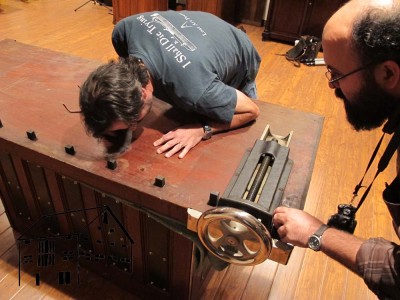
Collaborating with photographer Narayan Nayar and editor/publisher Chris Schwarz is an ongoing delight. The project patron and owner of the Studley ensemble is a man of astonishing accomplishments and insights whose company I relish. Our work setting within his menagerie is about the most wonderful work environment I have ever experienced as an aesthete and artifactualist. This definietly fits the description of what MikeM describes as the point of work.
Immediately after wrapping up WIA in Cincinnati we loaded up the car and headed to North Tulsapolis, Montaska for my fifth visit to the collection for our final scheduled session of photography. What made this trip extra special was that on this time we would be joined by vise maven Jameel Abraham to provide me another set of expert and experienced eyes in my final examination of the vises on Studley’s bench before I ramp up weaving all the research into a compelling book.
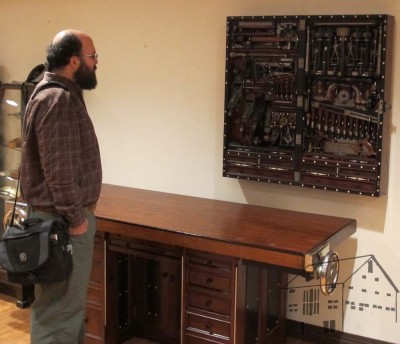
As is usually the case, Jameel’s reaction to the ensemble was stasis. He stared for several minutes before I cajoled him into the work at hand.
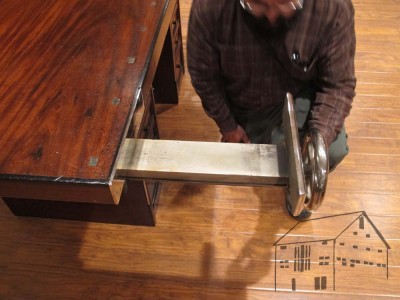
Like me and all who have witnessed this before him, Jameel was much impressed by a face vise that opened 16″ with zero wiggle. I mean zero.
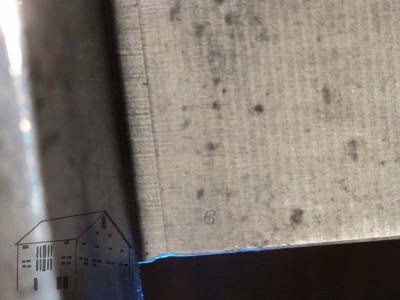
The information in just this image is worth many thousand words of description.
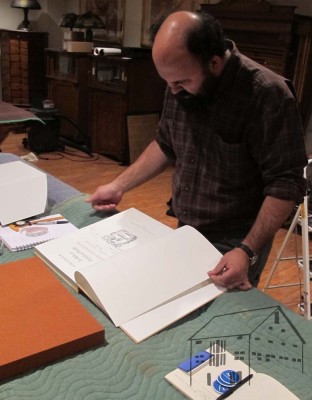
Finally, after some pathetic nagging from me, he opened his copy of the Deluxe Edition. His silent smile was gratifying.
Yup, interesting projects, great people, fun places.
I was scheduled to be on stage first thing Saturday morning, starting at 8.30. I was somewhat concerned about the long-ish time slot of 8.30 – 12.30 for my talk “The Transition From Hand Tools to Machines” since I had given a version that before and it was only about 75 minutes long. Megan thought I might start at 9, add a bit more information, and have some Q&A and that way maybe fill up two hours.
Even while driving in to the Convention Center it was apparent that this plan would not work. At about 8.20 Megan called and said “The crowd is here and they are restless.” Fortunately I was just pulling into the parking garage and was at my appointed place at my appointed time.
In fact the expanded time slot allowed me to explore many of the topics in much greater detail than before, and even after a halftime break the audience remained large and attentive. Wilbur Pan posted a concise if tongue-in-cheek review of the session here.
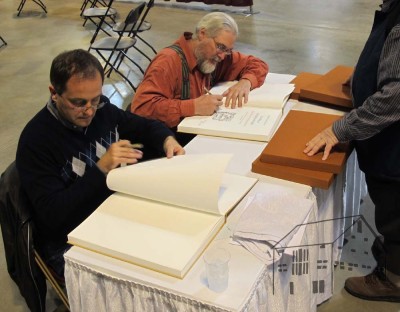
Three-plus hours later I stopped talking and made my way down to The Marketplace where Philippe Lafargue and I were to go on display and spend the afternoon signing hundreds of copies of To Make As Perfectly As Possible: Roubo On Marquetry. After a quick lunch we took our stations at a table adjacent to the Lost Art Press booth and met the long line of folks waiting patiently for our signatures.
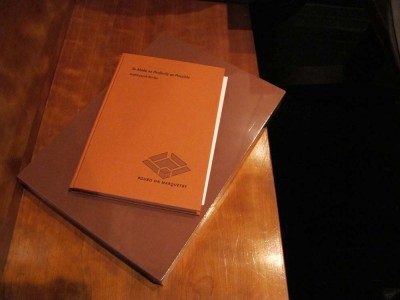
The book’s Standard Edition is something like 9×12 inches, and the Deluxe Edition twice as big, which means we were wrangling a lot of awkward poundage of books, signing until our arms nearly fell off. We were quite literally taken aback by the enthusiasm and encouragement of the crowds patiently waiting in line to spend time with us.
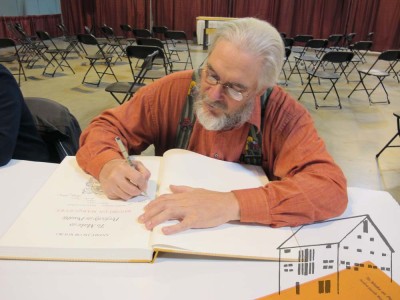
It was a serious time of celebration and delight, and the only way it could have been better if our collaborator Michele Pagan had been able to join us as well. Her absence due to an unavoidable previous commitment was noted by everyone.
Late in the afternoon I returned Philippe to the airport for his flight home, promising each other to get together sooner than another decade, then concluded the evening at a raucous celebration at the Schwarz household. Bed could not come soon enough after that.
Reposted from the Lost Art Press website
================================================
 The standard edition of “To Make as Perfectly as Possible: Roubo on Marquetry” is now available for pre-publication ordering. If you order before Oct. 10, 2013, when the book ships, you will receive free domestic shipping.
The standard edition of “To Make as Perfectly as Possible: Roubo on Marquetry” is now available for pre-publication ordering. If you order before Oct. 10, 2013, when the book ships, you will receive free domestic shipping.
The book is $43 and is available in our store here.
We had announced earlier that the book would be $40, but because of some last-minute changes to the printing specifications, we had to raise the price to $43. Apologies.
About the Book
“To Make as Perfectly as Possible: Roubo on Marquetry” is the first English-language translation of the most important woodworking book of the 18th century.
A team of translators, writers, woodworkers, editors and artists worked more than six years to bring this first volume of A.-J. Roubo’s work to an English audience. (Future volumes of Roubo’s other works on woodworking are forthcoming.)
While the title of this work implies that it is about marquetry alone, that is not the case. “To Make as Perfectly as Possible” covers a wide range of topics of interest to woodworkers who are interested in hand-tool woodworking or history.
In addition to veneer and marquetry, this volume contains sections on grinding, sharpening, staining, finishing, wood selection, a German workbench, clock-case construction, engraving and casting brasses.
But most of all, “To Make as Perfectly as Possible” provides a window into the woodworking world of the 18th century, a world that is both strangely familiar and foreign.
Roubo laments the decline of the craft in the 18th century. He decries the secrecy many masters employed to protect craft knowledge. He bemoans the cheapening of both goods and the taste of customers.
And he speaks to the reader as a woodworker who is talking to a fellow woodworker. Unlike many chroniclers of his time, Roubo was a journeyman joiner (later a master) who interviewed his fellow tradesmen to produce this stunning work. He engraved many of the plates himself. And he produced this work after many years of study.
The Lost Art Press edition of “To Make as Perfectly as Possible” is printed to high standards rarely seen in the market today. Printed and bound in the United States, the 264-page book is printed on acid-free #60-pound paper in black and white. The pages are Smythe sewn so the book will be durable. And the cover is made from heavy 120-point boards covered in cotton cloth. The book is 8-1/2” x 12”.
In addition to the translated text, essays on the text from author Donald C. Williams and all of the beautiful plates, “To Make as Perfectly as Possible” includes an introduction by W. Patrick Edwards of the American School of French Marquetry, an appendix on the life of Roubo and a complete index.
The book’s table of contents is below and here. You also can download a sample section of the book here on sawing veneer with this link: Roubo sample pages.
“To Make as Perfectly as Possible: Roubo on Marquetry” is available direct from Lost Art Press and from our select retailers.
To Make as Perfectly as Possible
The Different Woods Appropriate for Cabinetry
Section I.
Description of the Woods of the Indies, and Their Qualities, Relative to Cabinetmaking
Alphabetic Table of the Foreign Woods
Why Not Dalbergisterie?
Descriptions of French Wood Appropriate for Cabinetry
Colors in general, and the Woods from the Indies and from France with Regards to their different colors and their nuances
The different Compositions of Dyes appropriate for dyeing Woods, and how to use them
Section II.
On the sawing of Wood appropriate for Cabinetmaking
On Sawing Veneer
Description of Cabinetmakers’ Tools
Section III.
The Frames [Cases] appropriate to receive Veneerwork, and how to prepare them and construct them
Of Simple Parquetry, or the Composing of it in General
The Parqueteur’s Tool Kit
Section I.
The diverse sorts of Compositions in general: some detail and the Arrangement of wood veneer
Various sorts of Compositions, straight as well as circular
Make Banding With Roubo’s Template Blocks
The manner of cutting and adjusting the pieces so they are straight, and the proper Tools
Cutting and Assembling Cubic Hexagons
The manner of cutting curved pieces, and the tools that are appropriate
The 18th-century Shoulder Knife
Section II.
The manner of gluing and veneering Marquetry
Why Does Hammer Veneering Work? And How Can it be Made Better? 117
Section III.
The way to finish Veneer Work, and some different types of polish
Finishing Marquetry
Ornate Cabinetry, Called Mosaic Or Painted Wood, An Overview
Section I.
Elementary principles of Perspective, which knowledge is absolutely necessary for Cabinetmakers
Section II.
On the manner of cutting out, shading and inlaying Ornaments of wood
The way to engrave and finish wooden Ornaments
Section III.
How to represent Flowers, Fruits, Pastures and Figures in wood
Floral Marquetry
On the Third Type of (Veneered) Cabinetry in General
Section I.
Description of the different materials that one uses in the construction of the third type of veneered Cabinetry
On the Nature of Tortoiseshell
Mastic and ‘Mastic’
Section II.
Works for which one uses the third type of Cabinetmaking
Section III.
How to work the different materials that are used in the construction of Marquetry, like Shell, Ivory, Horn, etc.
Section IV.
The manner of constructing Inlay and finishing it
I. General Idea of the different types of Mosaic
Metal Casting
II. Ornaments in Bronze in general
III. The way to solder the Metals which one uses for different works of Cabinetry
IV. Description and practice of a Varnish appropriate to varnish and gild copper and other metals
Conclusion to the Art of Woodworking
Appendix: André-Jacob Roubo
Index
— Christopher Schwarz
Chris Schwarz just posted my newest contribution to the Lost Art Press Blog. You can see it here. My ongoing exploration of these vises and my efforts to replicate them will mostly occur ay my blog, so stay tuned.












Recent Comments